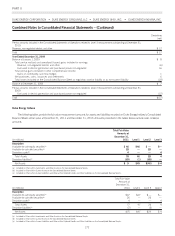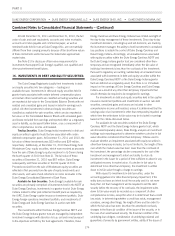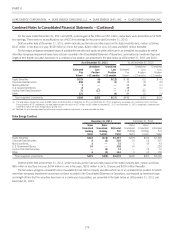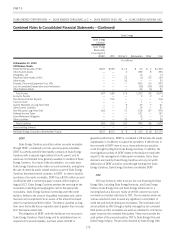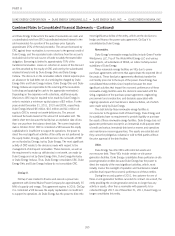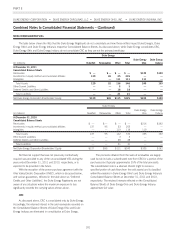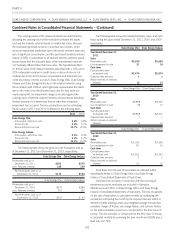Duke Energy 2011 Annual Report Download - page 199
Download and view the complete annual report
Please find page 199 of the 2011 Duke Energy annual report below. You can navigate through the pages in the report by either clicking on the pages listed below, or by using the keyword search tool below to find specific information within the annual report.
PART II
DUKE ENERGY CORPORATION •DUKE ENERGY CAROLINAS, LLC •DUKE ENERGY OHIO, INC. •DUKE ENERGY INDIANA, INC.
Combined Notes to Consolidated Financial Statements – (Continued)
Duke Energy
Duke Energy
Carolinas
Duke Energy
Receivables
Financing LLC
(DERF) CRC CinCap V Renewables Other Total
(in millions)
At December 31, 2010
VIE Balance Sheets
Restricted Receivables of VIEs $637 $629 $ 12 $ 20 $ 4 $1,302
Other Current Assets — — 4 282 8 294
Intangibles, net — — — 13 — 13
Restricted Other Assets of VIEs — — 76 (2) 65 139
Other Assets — — 23 — — 23
Property, Plant and Equipment Cost, VIEs — — — 892 50 942
Less Accumulated Depreciation and Amortization — — — (26) (29) (55)
Other Deferred Debits — — — 24 (3) 21
Total Assets 637 629 115 1,203 95 2,679
Accounts Payable — — — 2 2 4
Non-Recourse Notes Payable — 216 — — — 216
Taxes Accrued — — — 1 — 1
Current Maturities of Long-Term Debt — — 9 45 7 61
Other Current Liabilities — — 5 16 — 21
Non-Recourse Long-Term Debt 300 — 71 518 87 976
Deferred Income Taxes — — — 191 — 191
Asset Retirement Obligation — — — 12 — 12
Other Liabilities — — 22 4 — 26
Total Liabilities 300 216 107 789 96 1,508
Noncontrolling interests — — — — 1 1
Net Duke Energy Corporation Shareholders’ Equity $337 $413 $ 8 $ 414 $ (2) $1,170
DERF.
Duke Energy Carolinas securitizes certain accounts receivable
through DERF, a bankruptcy remote, special purpose subsidiary.
DERF is a wholly-owned limited liability company of Duke Energy
Carolinas with a separate legal existence from its parent, and its
assets are not intended to be generally available to creditors of Duke
Energy Carolinas. As a result of the securitization, on a daily basis
Duke Energy Carolinas sells certain accounts receivable, arising from
the sale of electricity and/or related services as part of Duke Energy
Carolinas’ franchised electric business, to DERF. In order to fund its
purchases of accounts receivable, DERF has a $300 million secured
credit facility with a commercial paper conduit, which expires in
August 2013. Duke Energy Carolinas provides the servicing for the
receivables (collecting and applying the cash to the appropriate
receivables). Duke Energy Carolinas’ borrowing under the credit
facility is limited to the amount of qualified receivables sold, which
has been and is expected to be in excess of the amount borrowed,
which is maintained at $300 million. The debt is classified as long-
term since the facility has an expiration date of greater than one year
from the balance sheet date.
The obligations of DERF under the facility are non-recourse to
Duke Energy Carolinas. Duke Energy and its subsidiaries have no
requirement to provide liquidity, purchase assets of DERF or
guarantee performance. DERF is considered a VIE because the equity
capitalization is insufficient to support its operations. If deficiencies in
thenetworthofDERFweretooccur,thosedeficiencieswouldbe
cured through funding from Duke Energy Carolinas. In addition, the
most significant activity of DERF relates to the decisions made with
respect to the management of delinquent receivables. Since those
decisions are made by Duke Energy Carolinas and any net worth
deficiencies of DERF would be cured through funding from Duke
Energy Carolinas, Duke Energy Carolinas consolidates DERF.
CRC.
CRC was formed in order to secure low cost financing for Duke
Energy Ohio, including Duke Energy Kentucky, and Duke Energy
Indiana. Duke Energy Ohio and Duke Energy Indiana sell on a
revolving basis at a discount, nearly all of their customer accounts
receivable and related collections to CRC. The receivables which are
sold are selected in order to avoid any significant concentration of
credit risk and exclude delinquent receivables. The receivables sold
are securitized by CRC through a facility managed by two unrelated
third parties and the receivables are used as collateral for commercial
paper issued by the unrelated third parties. These loans provide the
cash portion of the proceeds paid by CRC to Duke Energy Ohio and
Duke Energy Indiana. The proceeds obtained by Duke Energy Ohio
179





